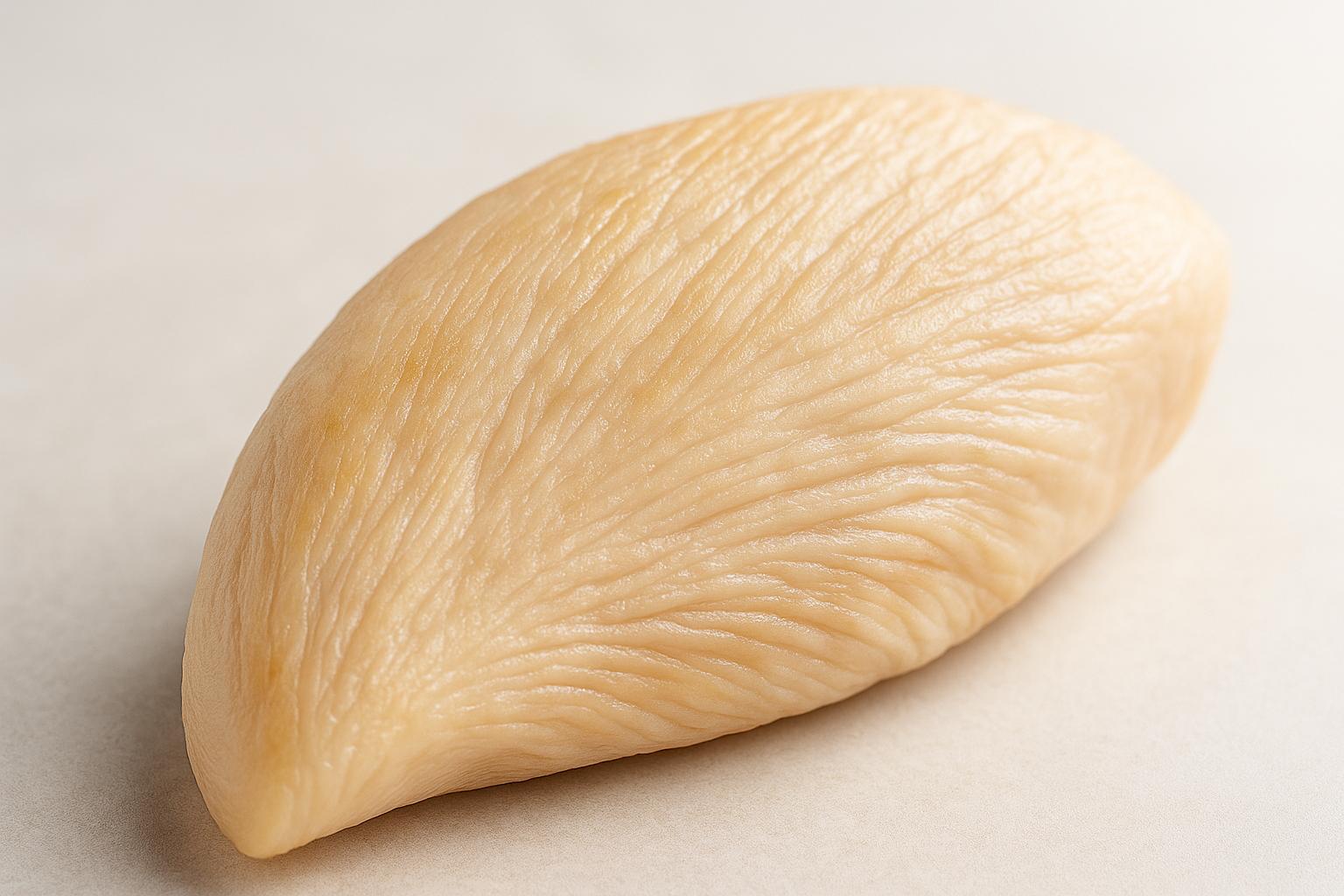Cultivated chicken is made from real chicken cells grown outside of animals. It tastes and feels very similar to conventional chicken, with only minor differences. Blind taste tests show that most people can't tell them apart, especially when seasoned or cooked in familiar dishes. However, cultivated chicken may have a slightly milder flavour, less fat, and a drier texture compared to its conventional counterpart.
Key Points:
- Taste: Nearly identical to conventional chicken but slightly milder.
- Texture: Comparable, though it can feel drier due to lower fat content.
- Cooking: Performs well in dishes like nuggets or burgers; seasoning enhances its flavour.
- Flavour Notes: Lower umami and richness compared to traditional chicken.
While there are subtle differences, cultivated chicken offers a close match to the chicken you know, with the added benefit of being produced without farming animals.
What Does Lab-Grown Meat Taste Like? We Test It Out
Taste and Texture: How Does Cultivated Chicken Compare?
Blind taste tests reveal that cultivated chicken closely resembles conventional chicken in both flavour and texture. Designed to mimic traditional poultry, it delivers the familiar taste and mouthfeel people associate with chicken.
The texture of cultivated chicken often aligns with that of its conventional counterpart, thanks to muscle fibres formed during the cultivation process. However, subtle differences can arise. For example, cultivated chicken may feel slightly drier due to its lower fat content and the absence of skin, which typically adds richness in traditional chicken.
What Taste Testers Say About Cultivated Chicken
In blind tastings, both professional chefs and everyday consumers often report difficulty distinguishing between cultivated and conventional chicken. Many describe the two as nearly identical in taste, texture, and overall substance [3][6].
When differences are noted, they are generally minor. Some tasters have mentioned that cultivated chicken may have a slightly milder flavour or benefit from added fat - especially when tasted without seasoning [5][6]. Research also suggests that cultivated chicken tends to have lower umami and bitterness levels compared to traditional chicken, although its saltiness is similar [7]. The mouthfeel is particularly comparable in ground or minced forms [3][5].
These findings highlight how preparation can further enhance the eating experience.
How Cooking and Preparation Affect Taste
Cooking methods and product formats significantly influence the sensory experience of cultivated chicken. When used in nuggets, burgers, or other structured dishes, cultivated chicken delivers a taste and texture that’s nearly indistinguishable from conventional chicken [5]. These formats allow for added fats, seasonings, and binders, which enhance flavour and texture while minimising any minor differences.
Cooking techniques such as roasting, frying, and grilling create similar browning, aroma, and texture to traditional chicken [5]. However, unseasoned minced cultivated chicken can reveal slight variations, such as a drier texture or less richness due to its lower fat content [5][6].
What Makes Cultivated Chicken Taste Like Chicken?
To understand why cultivated chicken can replicate the flavour of traditional chicken, we need to look at its biochemical makeup. The distinct taste of chicken comes from specific compounds naturally found in muscle tissue. These molecules are the key to why cultivated chicken can closely resemble the flavour of its conventional counterpart.
The Role of Amino Acids and Umami Compounds
Amino acids, particularly glutamic acid, and nucleotides like inosine monophosphate (IMP), are the main contributors to chicken's savoury, umami taste. Glutamic acid delivers the basic savoury notes, while IMP enhances and deepens the overall umami experience.
However, research shows that cultivated chicken tends to have lower levels of glutamic acid and IMP compared to conventional chicken[4]. This slight difference could explain why some taste tests report a milder umami flavour, though many testers find the variation barely noticeable.
How Production Methods Affect Flavour
The flavour of cultivated chicken is heavily influenced by the composition of its growth medium. Adjusting the nutrients in the medium can alter the levels of umami compounds, bitterness, and other flavour characteristics[7]. By adding specific nutrient precursors, producers can increase glutamic acid and IMP levels, bringing the flavour profile closer to that of conventional chicken.
Additionally, the metabolic activity of the cultured cells plays a role in flavour development. Cells with higher metabolic activity produce more IMP, which boosts the umami taste. Fine-tuning cell culture conditions - such as temperature, pH, and nutrient availability - is therefore essential for achieving a flavour that matches traditional chicken.
In March 2022, SuperMeat held a blind tasting at its Tel Aviv restaurant, The Chicken. Professional chefs and food critics, including "Master Chef" judge Michal Ansky, were unable to consistently tell the difference between cultivated and conventional chicken when served unseasoned and unprocessed. Ansky remarked, "I'm extremely happy I was wrong... It's inspiring to see a more sustainable future can be achieved via cultivated meat."[3]
This example shows that with well-optimised production techniques, cultivated chicken can successfully replicate the intricate biochemical profile that gives conventional chicken its authentic taste.
Consumer Reactions and First Impressions
When it comes to cultivated chicken, early consumer feedback highlights its surprising familiarity. From taste to texture, initial reactions from tasters, food experts, and critics often reflect astonishment at how closely it mirrors traditional chicken.
Public Tastings and Early Reviews
Public tastings have become a key moment of truth for cultivated chicken, often delivering results that surpass expectations. Professional chefs and food critics participating in blind tastings frequently struggle to tell it apart from conventional chicken. Many have shared positive remarks about its quality and the way it replicates the essence of traditional chicken[3][6].
In sensory tests involving untrained participants, 67% of 30 individuals preferred cultivated chicken over soy-based alternatives when evaluating taste, texture, and overall sensory experience[2]. When asked how likely they would be to replace conventional meat with cultivated chicken, participants gave an average score of 8 out of 10[2]. These promising results naturally lead to further examination of its appearance, aroma, and mouthfeel.
Appearance, Aroma, and Mouthfeel
The appeal of cultivated chicken extends beyond taste, with testers also noting its visual and textural similarities to conventional chicken. Its colour, texture, and overall appearance are frequently described as nearly identical to the real thing[2][3]. The mouthfeel, in particular, has received glowing feedback, with participants praising its familiar bite, chewiness, and structural consistency[2][3].
Aroma feedback is generally positive, though some tasters have pointed out subtle differences. When served plain, cultivated chicken tends to have a slightly milder scent[7]. Additionally, a few testers noted that it can feel less rich or fatty compared to traditional chicken, especially in unseasoned or unprepared samples[6].
Even with these minor distinctions, first impressions remain overwhelmingly positive. Many consumers report being surprised by how closely it resembles conventional chicken. Initial scepticism often gives way to curiosity, particularly about its potential role in creating a more sustainable food system. This sense of familiarity suggests that when cultivated chicken becomes available in the UK, its integration into daily diets may be easier than expected.
sbb-itb-c323ed3
How Cultivated Chicken Compares to Conventional Chicken
Many people are curious about how cultivated chicken stacks up against the conventional chicken we've been eating for generations. Let’s break it down.
Taste-wise, they’re strikingly similar. In blind taste tests, even professional chefs often struggle to tell them apart. Some do notice slight flavour differences, but these are usually minor [3] [5] [6]. Texture is also comparable, especially in dishes like burgers and nuggets, where cultivated chicken closely mimics its conventional counterpart. That said, cultivated chicken can sometimes feel a bit drier because it has less fat and lacks skin [5].
When it comes to flavour, studies suggest cultivated chicken has slightly less umami and a touch more astringency compared to conventional chicken [7]. The lower fat content also means it’s less juicy and flavourful overall [6]. However, what cultivated chicken lacks in fat and umami, it makes up for with its ethical and environmental benefits - no animals are slaughtered in the process [3].
Here’s a quick comparison of the two:
Comparison Table: Cultivated vs Conventional Chicken
| Attribute | Cultivated Chicken | Conventional Chicken |
|---|---|---|
| Taste | Very similar; sometimes richer or less salty [3] [5] [6] | Familiar; often more pronounced flavour [5] [6] |
| Texture | Similar; can feel drier due to less fat/skin [5] | Juicier, with more variation in cuts [5] |
| Umami | Lower compared to conventional [7] | Higher umami intensity [7] |
| Fat Content | Generally lower [6] | Variable; often higher [6] |
| Appearance | Similar; slight colour differences [5] | Familiar; natural variation [5] |
| Consumer Reaction | Positive; many are open to switching [2] [3] | Familiar; often preferred out of tradition |
| Environmental Impact | Lower impact, no animal slaughter [3] | Higher impact, with animal welfare concerns [3] |
While cultivated chicken mirrors conventional chicken in many ways, there are subtle differences in fat content, umami, and texture. Still, its ethical and environmental benefits are hard to ignore.
Cultivated Meat Shop: Your Guide to the Future of Meat

Cultivated Meat Shop is here to give you a clearer picture of what the future of cultivated meat looks like, especially when it comes to taste and texture. If you've ever wondered what cultivated chicken tastes like, this platform has the answers.
For those keen to stay informed, Cultivated Meat Shop serves as a reliable source for insights, product updates, and educational content about cultivated chicken. It builds on the taste comparisons already discussed, offering a deeper dive into what sets cultivated chicken apart.
The "Insights & News" section is particularly handy, breaking down how production methods influence flavour and providing comparisons between cultivated chicken and traditional meat.
Through its waitlist, Cultivated Meat Shop also gives early access to product previews and updates on regulatory progress. This means you'll be among the first to know when cultivated chicken becomes available in the UK. Armed with this information, you'll be better equipped to make informed decisions.
The platform avoids overwhelming technical language, instead explaining key factors like how production methods shape flavour, why amino acids and umami compounds are important, and what early taste testers have to say about their experiences. This straightforward and transparent approach ensures you're well-informed and confident in your choices.
All content is tailored specifically for UK consumers, using British English, metric measurements, and pounds sterling. It also addresses local concerns around diet and sustainability, making it highly relevant for the UK audience.
Whether you're a flexitarian aiming to lower your environmental footprint, a food lover intrigued by cutting-edge developments, or just someone curious about the buzz around cultivated meat, Cultivated Meat Shop positions itself as your go-to resource for understanding this practical alternative to conventional chicken.
What to Expect from Cultivated Chicken
Taste tests have shown that cultivated chicken comes very close to matching the flavour and texture of traditional chicken. In fact, it has even impressed in blind taste studies, especially when seasoned well. When used in familiar recipes like chicken burgers, its taste profile is remarkably similar to its conventional counterpart. Even those who were initially sceptical have noted its distinct chicken flavour when prepared properly[5]. While there are some minor differences - such as slightly less umami and occasional textural variations in certain forms - these are hardly noticeable when the chicken is part of a cooked dish[5][7].
As production techniques evolve, the eating experience is expected to get even better. Researchers are currently working on fine-tuning the umami compounds and adjusting fat content to bring cultivated chicken even closer to the real thing[7].
For those in the UK keen to stay updated on cultivated chicken's progress, the Cultivated Meat Shop provides regular updates through its waitlist and educational resources. Recent articles, including those from October 2025, offer insights into taste comparisons and regulatory milestones[1]. This way, you'll be ready to try this new protein option as soon as it becomes available.
Cultivated chicken offers a practical way to enjoy meat sustainably, without sacrificing taste, texture, or versatility in your favourite dishes.
FAQs
Does cultivated chicken taste different from conventional chicken?
Cultivated chicken is crafted to replicate the taste of traditional chicken because it’s made from the same animal cells. The production process ensures the flavour, texture, and overall experience align with what people expect from the chicken they’re used to.
What sets cultivated chicken apart is the controlled environment in which it’s grown. Everything from the feed to the growth conditions and cell development is carefully managed. This precision could even open the door to tailoring flavour and texture in the future to meet individual preferences. For now, consumers can enjoy a taste that feels familiar, offering a satisfying and forward-thinking alternative to conventional chicken.
What are the environmental and ethical benefits of choosing cultivated chicken?
Choosing cultivated chicken comes with notable environmental and ethical benefits when compared to traditional chicken farming. By sidestepping large-scale animal agriculture, it can significantly cut greenhouse gas emissions, save water, and require far less land. This shift supports a greener, more environmentally conscious food system.
From an ethical perspective, cultivated chicken removes the need to rear and slaughter animals, directly addressing concerns around animal welfare. It offers the chance to enjoy real meat without the moral challenges linked to conventional farming methods.
Will cultivated chicken taste and feel as good as conventional chicken in the future?
The flavour and texture of cultivated chicken could one day rival - or even surpass - those of traditional chicken. As the science behind cultivated meat continues to progress, producers are working hard to fine-tune the taste and texture to meet, and potentially exceed, what consumers expect.
Cultivated meat offers a chance to enjoy real chicken with the same satisfying taste and feel, but without relying on conventional farming practices. Though this field is still evolving, the outlook is bright for creating cultivated chicken that’s just as good as - or maybe even better than - the chicken you know.












